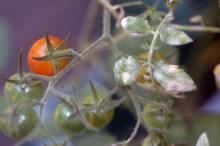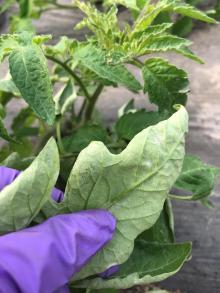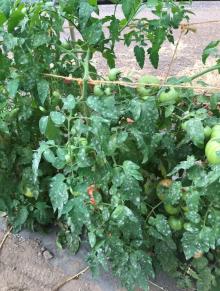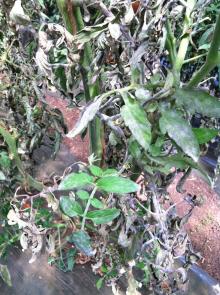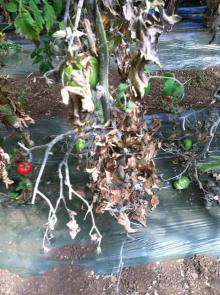Cause The fungi, Leveillula taurica (syn. = Oidiopsis taurica, Erysiphe taurica) and Oidium neolycopersici (syn. = Pseudoidium neolycopersici), are both occurring on tomato in western Oregon. Oidium lycopersici has been reported on tomato in California. Powdery mildew can be more severe under warm, semiarid conditions, and severe disease outbreaks can develop in plastic tunnels or greenhouses. Leveillula taurica has a wide crop and weed host range on which it can overwinter. Oidium neolycopersici is primarily a problem on tomato but can infect a few taxa of the Solanaceae family.
Temperatures below 86°F favor infection; higher temperatures accelerate symptoms once infection is established. Cool nights permit infection in areas with high daytime temperatures.
Symptoms Light green to bright yellow, irregularly-shaped blotches develop on upper leaf surfaces and may or may not be accompanied by a profuse whitish sporulation on the upper and/or lower leaf surface; the lesion centers later turn necrotic. Individual leaves die but can stay on the plant. Severe infections can result in leaf deformities. Leveillula taurica usually is seen as a whitish powdery growth on the leaf's lower side, but it sporulates only sparsely. Oidium neolycopersici can produce a profuse white powdery growth on the upper leaf surface, and if humidity is high, sporulation can occur on the underside of leaves; the whitish sporulation can also occur on stems and petioles.
Cultural control
- Plant resistant varieties if available. The varieties, Geronimo F1, Granadero F1, Massada F1, and Striped Stuffer are reported to have resistance to powdery mildew.
- Plant powdery mildew-free transplants.
- Destroy infected crop debris after harvest.
- Enhance air circulation, including by plant spacing, pruning, and staking of plants.
- Apply sufficient nitrogen to meet crop demands, but avoid excessive fertilization that can lead to dense, lush plant growth.
Chemical control
- Copper (Group M1) products are not recommended as stand-alone materials but can enhance efficacy when tank-mixed with certain other fungicides.
- Cueva at 0.5 to 2 gal/100 gal water on 7- to 10-day intervals. May be applied on the day of harvest. 4-hr reentry. O
- Kocide 2000 at 1.5 to 3 lb/A or Kocide 3000 at 0.75 to 1.75 lb/A on 5- to 10-day intervals. 48-hr reentry. O
- Fontelis (Group 7) at 10 to 24 fl oz/A on 7- to 14-day intervals. Do not make more than two (2) sequential applications before alternating to a labeled fungicide with a different mode of action (non-Group 7). Preharvest interval is 0 days. 12-hr reentry.
- Mettle 125 ME (Group 3) at 6 to 8 fl oz/A on 7- to 14-day intervals. Application can be made the day of harvest. 12-hr reentry.
- Oils can add in disease management but not usually as stand-alone products.
- Cinnerate at 13 to 30 fl oz/100 gallons of water. Do not spray if temperature is above 90°F or when plants are under heat or moisture stress. O
- JMS Stylet Oil at 3 to 6 quarts/100 gal water. Do not spray if temperature is below 50°F, above 90°F or when plants are wet or under heat or moisture stress. 4-hr reentry. O
- Timorex Gold (Group F7; tree tea oil) at 0.1 to 0.6 fl oz/gal. Studies at UC-Davis showed that applications on 10-day intervals suppressed powdery mildew severity but not incidence. Preharvest interval is 2 days. 24-hr reentry. O
- OSO 5% SC (Group 19) at 3.75 to 13 fl oz/A on 7- to 14-day intervals. Can be applied the day of harvest. 4-hr reentry.
- Potassium bicarbonate formulations might supplement a normal program when powdery mildew is first observed. Thorough coverage is critical. Studies by OSU have shown good efficacy when used as a weekly preventative application in plastic tunnels.
- Bi-Carb Old Fashioned Fungicide at 4 teaspoons/2 gal water on 7- to 10-day intervals. May be applied up to the day before harvest. H O
- Carb-O-Nator at 2.5 to 5 lb/100 gal of water on 5- to 14-day intervals, depending on disease pressure. Preharvest interval is zero (0) days for all listed crops. 4-hr reentry. O
- Kaligreen at 2.5 to 3 lb/A on 7- to 10-day intervals. May be applied up to the day before harvest. 4-hr reentry. O
- MilStop SP at 2 to 3 lb/A on 7- to 14-day intervals. May be applied on the day of harvest 1-hr reentry. O
- Vacres at 2.5 to 5 lb/A on 7- to 14-day intervals. Preharvest interval is zero (0) days. 4-hr reentry.
- Problad Verde (Group BM01) at 18.1 to 45.7 fl oz/A on 7- to 10-day intervals. Needs 8 to 12 hours dry time to absorb into treated tissue. Do not make more than two (2) sequential applications before rotating to a labeled fungicide with a different mode of action. Preharvest interval is 1 day. Reentry interval is 4 hours. O
- Rally 40 WSP or Sonoma WSP (Group 3) at 2.5 to 4 oz/A on intervals of up to 21 days. Can be applied on day of harvest. 24-hr reentry.
- Regalia (Group P5) at 1 to 4 quarts/A on 7- to 10-day intervals. Does not benefit from the addition of an adjuvant. Tank-mix with another fungicide for best control under high disease pressure. Studies at Cornell University using an older formulation (MOI-106) showed a decrease in powdery mildew incidence and severity, especially when tank-mixed with a copper and used on a preventive 7-day application schedule. Preharvest interval is 0 days. 4-hr reentry. O
- Rhyme (Group 3) at 5 to 7 fl oz/A. Alternate or tank-mix with a non-Group 3 fungicide for resistance management. Preharvest interval is 0 days. 12-hr reentry.
- Strobilurin-type fungicides (Group 11) have efficacy on powdery mildew. Do not apply more than one (1) foliar application any Group 11 fungicide before alternating to a labeled fungicide with a different mode of action.
- Cabrio EG at 8 to 16 oz/A on 7- to 14-day intervals. Preharvest interval is 0 days. 12-hr reentry.
- Quadris Flowable at 5 to 6.2 fl oz/A on 7- to 21-day intervals. Do not apply with an adjuvant. May be applied the day of harvest. 4-hr reentry.
- Sulfur products can be very effective for powdery mildew.
- Bayer Advanced Natria Insect, Disease, and Mite Control on 7- to 10-day intervals. Do not apply if temperature will exceed 90°F within 21 days of an oil application. H
- Microthiol Disperss at 5 to 20 lb/A on 7- to 10-day intervals. Do not apply if temperature will exceed 90°F within 3 days after application. 24-hr reentry. O
- Thiolux (80% sulfur) at 6 to 20 lb/A. Do not apply when temperatures are high. 24-hr reentry.
- Torino (Group U6) at 3.4 fl oz/A on no shorter than 14-day intervals. Preharvest interval is 0 days. 4-hr reentry.
Note: Premixes of fungicides are available and offer ease for fungicide resistance management. Do not make more than one (1) application of a Group 11 fungicide before alternating to a labeled fungicide with a different mode of action; for other fungicide groups apply no more than two (2) sequential applications alternating with another fungicide with a different mode of action.
- Affiance (Group 3 + 11) at 12 fl oz/A on 7- to 10-day intervals. Preharvest interval is 1 day. 12-hr reentry.
- Aprovia Top (Group 7 + 3) at 10.5 to 13.5 fl oz/A on 7- to 14-day intervals. Can be applied the day of harvest. 12-hr reentry.
- Dexter Xcel (Group M3 + 11 +3) at 36 fl oz/A on 7- to 10-day intervals. Preharvest interval is 7 days. 24-hr reentry.
- Inspire Super (Group 3 + 9) at 16 to 20 fl oz/A on 7- to 10-day intervals. Preharvest interval is 0 day. 12-hr reentry.
- Miravis Prime (Group 7 + 12) at 9.2 to 11.4 fl oz/A on 7- to 21- day intervals. Preharvest interval is 0 days. 12-hr reentry.
- Priaxor Xemium Brand (Group 7 + 11) at 6 to 8 fl oz/A on 7- to 14-day intervals. Preharvest interval is 0 day. 12-hr reentry.
- Quadris Opti (Group 11 + M5) at 1.6 pints/A on 7- to 21-day intervals. Do not apply until 21 days after transplanting or 35 days after seeding. Adjuvants should not be used. Preharvest interval is 0 days. 12-hr reentry.
- Quadris Top (Group 11 + 3) at 8 fl oz/A on 7- to 10-day intervals. Do not apply until 21 day after transplanting or 35 days after seeding. May be applied the day of harvest. 12-hr reentry.
- Revus Top (Group 3 + 40) at 5.5 to 7 fl oz/A on 7- to 10-day intervals. Do not use on varieties in which mature tomatoes will be less than 2 inches. Preharvest interval is 1 day. 12-hr reentry.
- Switch 62.5WG (Group 12 + 9) at 11 to 14 oz/A on 7- to 10-day intervals. Do not apply to small tomatoes in the greenhouse. May be applied the day of harvest. 12-hr reentry.
Biological control
- Actinovate AG at 3 to 12 oz/A as a foliar spray on 7- to 14-day intervals. Moderate disease control was found in Cornell studies where Actinovate was used with an organic surfactant and penetrant. 4-hr reentry. O
- Actinovate Lawn & Garden at 0.5 to 1 teaspoon/gal water. H O
- Double Nickel LC at 1 to 6 quarts/A on 3- to 10-day intervals. Can be applied the day of harvest. 4-hr reentry. O
- Ecoswing at 1.5 to 2 pints/A. Preharvest interval is 0 days. 4-hr reentry. O
- Romeo at 0.45 to 0.68 lb/A on 7- to 10-day intervals starting prior to infection. Preharvest interval is 0 days. 4-hr reentry. O
- Sonata at 2 to 4 quarts/A on 7- to 14-day intervals can suppress powdery mildew. Can be applied up to and on the day of harvest. 4-hr reentry. O
References Li, Y.H. 2013. Powdery Mildew of Tomato. The Connecticut Agricultural Experiment Station (https://portal.ct.gov/caes).
McGrath, M.T., and Fox, G.M. 2009. Efficacy of biopesticides for managing foliar diseases in organically-produced tomato, 2008. Plant Disease Management Reports 3:V127.
Nguyen, T.T. Bay, I.S., and Gubler, W.D. 2014. Management of tomato powdery mildew and early blight on cv. Shady Lady with organic and conventional fungicides, 2013. Plant Disease Management Reports 8:V232.
Ocamb, C.M., Buckland, K., Nackley, L., and Rasmussen, A.L. 2020. Evaluation of UV-B for powdery mildew control in hoop house tomato production in western Oregon, 2019. Plant Disease Management Report: Report No.14:V058.
Salvucci, A., Aegerter, B.J., Miyao, E.M., and Stergiopoulos, I. 2016. First Report of Powdery Mildew Caused by Oidium lycopersici in Field-grown Tomatoes in California. Plant Disease 100:1497


